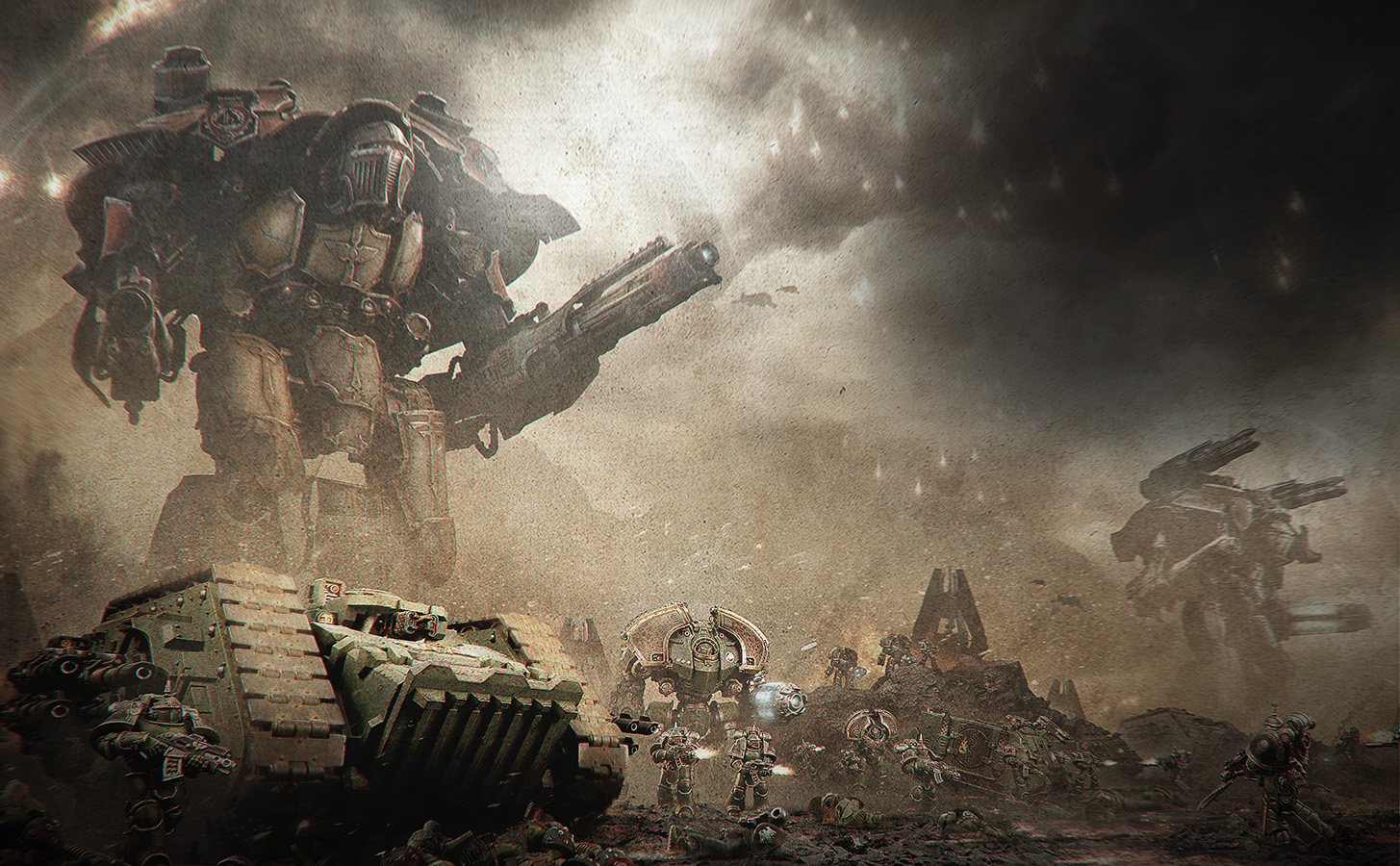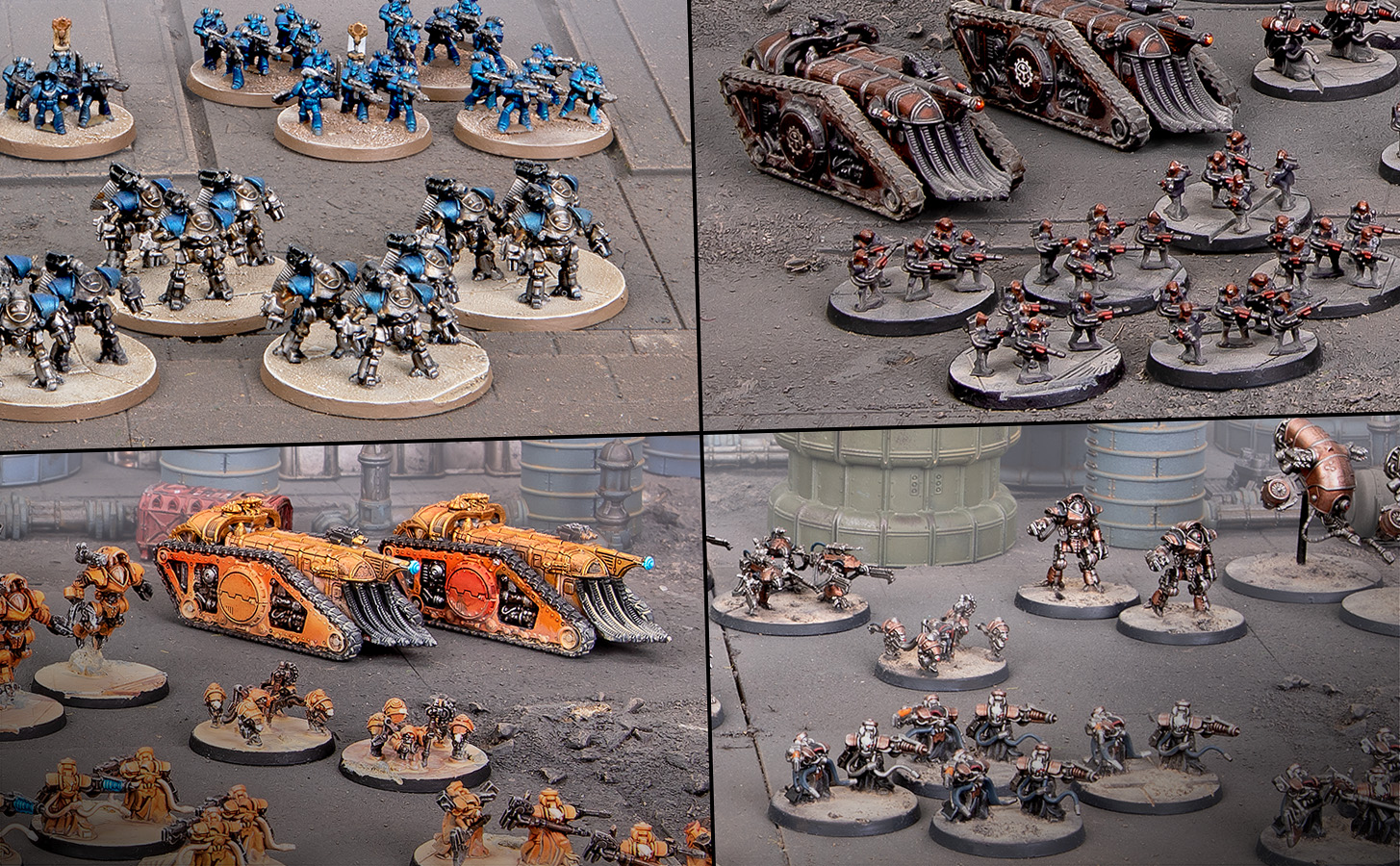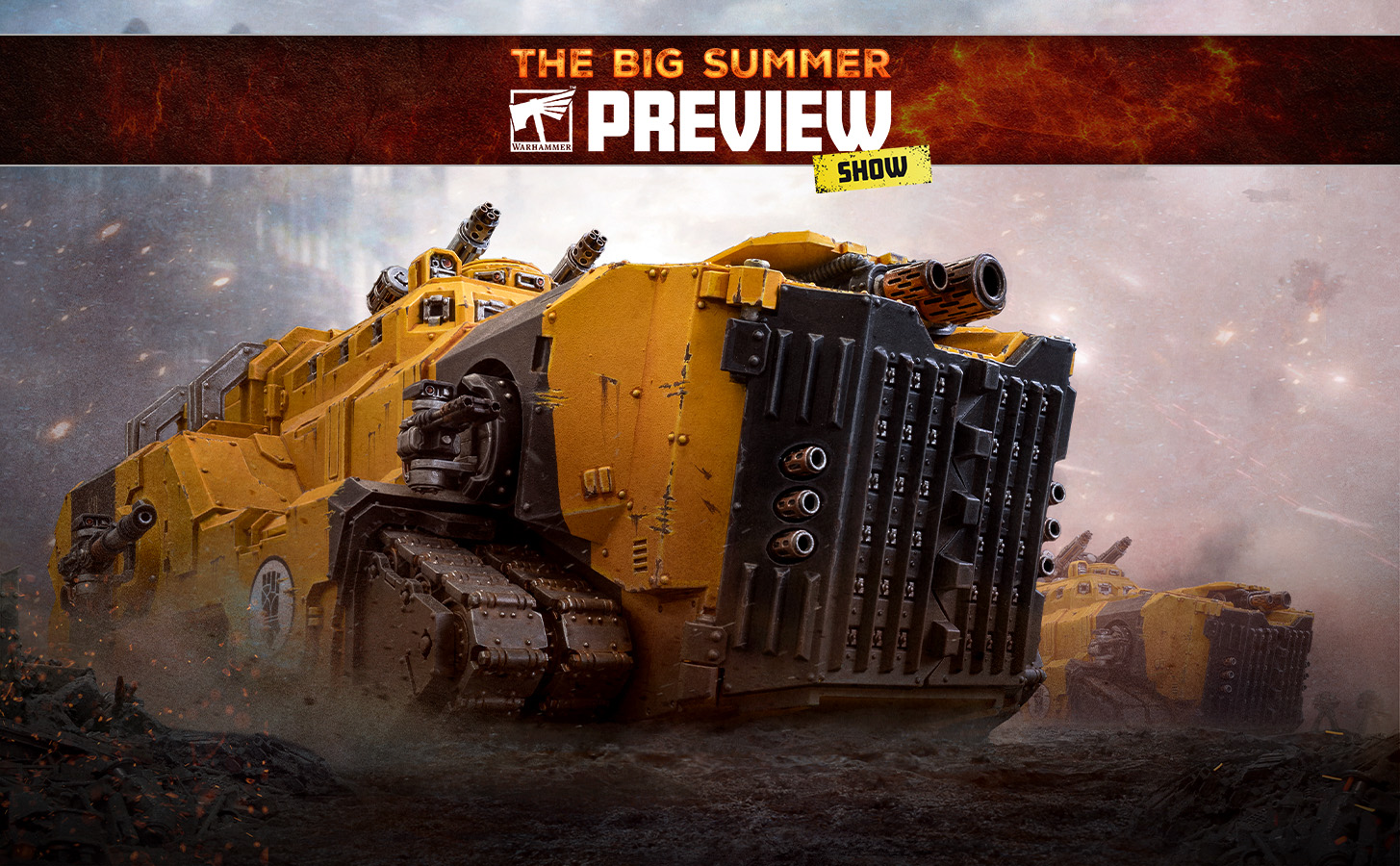Rise of the Dark Mechanicum is the latest supplement for Legions Imperialis, bringing armies of robots and technological abominations from either side of the Schism of Mars. One of the main fighting forces of the Mechanicum are the Legio Cybernetica, at the same time respected and feared due to their use of terrifying battle-automata.

You can now add Legio Cybernetica cohorts to your armies with Bonded Cybernetica Support Formations. Support Formations are a new type of Formation with simple rules for inclusion in your army lists: for every regular Formation chosen from a Core List, an army can include one Support Formation. Some of these give you the option to choose Detachments from other army lists – and unless otherwise stated, these units do not count as allies, nor towards the Allied Contingents points limit.
There are seven Formations: one each for the Legiones Astartes, Solar Auxilia, Mechanicum Taghmata, Dark Mechanicum and Collegia Titanica, and two for the Knight Households. Alongside special rules and Detachment lists, each also has a Designer’s Note giving you ideas on how you might want to convert or paint your miniatures.
The Brethren of Iron
As the relentless wars of the Horus Heresy continued, the Legions suffered losses on an apocalyptic scale. Most found some means of bolstering their ranks – some conventional, others arcane and proscribed. One fairly common method was to induct Cybernetica maniples directly into line units, with some even granted the honour of wearing Legion heraldry.
Brethren of Iron detachments provide a great chance to paint your automata in Legion heraldry. It is appropriate that the automata feature at least some parts painted in their parent Legion’s dominant colour, such as the shoulder pads shown in the example below. Perhaps especially long-serving maniples might feature automata entirely bedecked in the colours of their associated legion, wearing the signs of their allegiance for all to witness.

One of perhaps 30 such battle-automata kept in storage in deep subsurface vaults below the Zhao-Arkhad sub-fane on Prospero, MLIII is clad in the standard livery of the Taghmata forces attached to the Thousand Sons Legion in the latter part of the Great Crusade, and carries the icon of the Legion in addition to its own machine-cant designations upon its outer carapace.
Collegia Titanica Support Cohorts
The Collegia Titanica were paragons of war, but even god-engines required support on the battlefield. Some Titan Legions relied upon bonded automata to fulfil such a task, favouring the superiority of the machine and augmented Taghmata warriors than more traditional troops.
Collegia Titanica Support Cohorts offer another chance to paint Cybernetica constructs in the distinctive heraldry of another faction – in this case, the mighty Titan Legios. As with the Brethren of Iron, how much of each automata’s form is painted in the livery of the parent unit is a matter of taste. The example below shows a Castellax resplendent in the yellow and dappled grey of the Legio Gryphonnicus.

Omega Pi Seven was one of around 100 Battle-automata ceded by the Legio Cybernetica to fight in the ranks of the Legio Gryphonicus in return for reciprocal aid, furthering their own interests. Fully bonded to the Legio Gryphonicus, Omega Pi Seven bears the colours of the militant forces of the forge world of Gryphonne IV, including the heraldry of the Titan units it is supporting. On Paramar V, it was assigned to the secondary demi-maniple of nine automata tasked with the defence of particularly valuable promethium conduits leading from the extraction sinks in that region. Omega Pi Seven’s ultimate fate following the Traitor assault on Paramar V remains unlisted in the archives of the Legio Cybernetica, as do those of the two Tech-Priests assigned as overseers.
Knight Household Retainer Cohorts and Aegis Cohorts
A Knight Household tightly bound to a forge world would often rely upon Taghma elements to support its scions on the battlefield. Vorax and Vultarax were commonly inducted into Knight Lances, where the automata would serve as pathfinder and vanguard elements in concert with Knight Armigers.
During protracted campaigns, where repairs of Knight armours were extensive, and losses mounted, lances would be supplemented by automata to ensure continued combat readiness. The Knight Scions in question were temporarily given the command ciphers necessary to alter automata programming to allow battlefield control.
These formations are a great way to expand an existing collection of Knight armours and to paint them in the colours of the Questoris Familia, of which there are numerous examples to follow.

Pictured here during the mustering of the Censure Host against the Thousand Sons, Vultarax of the Delta-xel Nagri maniple were one of four maniples inducted directly into the service of House Malinax. On Prospero, the Vultarax were utilised to encircle military personnel in the ruins of Tizca. Based upon later reports, the Delta-xel Nagri maniple remained bound to House Malinax, its Vultarax seen accompanying the Household on at least four separate instances, including during the campaigns of Beta-Garmon.
Ironbound Ruinhost
Many Magos willingly infected their existing Taghmata with malignant scrapcode, burning out the sanctified machine spirits and allowing malefic spirits to inhabit the now vacant cybernetica cortex. Such creations burned with internal power, their new animating power driving them forward with an incessant hunger to slaughter.
The Ironbound Ruinhost is made up of rank after rank of corrupted automata, led into battle by a fallen magi of the Dark Mechanicum. They are a great opportunity to go to town on brooding colour schemes, as well as weathering, degradation or other signs of corruption.

This Castellax was part of the Dark Mechanicum throng engaged in the Perditum Incursion. Broadcasting a seemingly random string of characters from its animus/inimicus transponder, it displayed the same frenzy which gripped all of its fellow battle-automata. Of note is the Iungum Cybernetica sigil which marks its left pauldron, signifying that this automata was not created in the famously industrious forges of Mondus Gamma, but may instead have been gifted by another magi seeking favour, or demanded by Lukas Chrom as tribute. Whether the corruption of its cybernetica cortex occurred before this transfer of ownership or subsequently is unclear.
Iron Cohort
Many Solar Auxilia cohorts would reinforce their fighting strength from the forge worlds they had fought alongside, supplementing their infantry with maniples of automata. Given the brutal efficiency of such war machines, the Divisio Militaris has done little to discourage such traditions, though these ‘Iron Cohorts’ would often find themselves assigned to the most gruelling and deadly war zones.
Iron Cohorts might be painted in the utilitarian Excertus Imperialis service grey* of the First Line Solar Auxilia cohorts or in the Legion-derived ‘honour livery’ of one of the Legiones Auxilia cohorts.

When the 1,522nd Solar Auxilia cohort – the so-called ‘Lord Marshal’s Own’ – remobilised at the outset of the Horus Heresy to resist the Traitors’ conquest of the Coronid Reach, several maniples of bonded battle-automata would be counted among its muster, though the Castellax depicted is far older than such deployments might suggest. Originally ceded to the world of Agathon decades prior to the civil war, Epilektos-𝚵-72 formed part of an exchange with the archmagos-overlords of Cyclothrathe who required a constant stream of indentured labourers for ongoing mining efforts, a supply partially met by the ogryns of Othion, a world under rulership of the Agathon Domain. Liveried in the colours of the Lord Marshal’s Own and sent to war alongside the soldiery of Agathon, it is a grim twist of fate that Epilektos-𝚵-72 and its counterpart automata would do battle with the Taghmata of Cyclothrathe on several occasions during the wars of the Horus Heresy.
Itinerant Cybernetica Cohort
Where magi were not present to excise dissonance cascades and logic-errors, many would begin expressing aberrant programming within their cortex engrams. In the most extreme cases automata cohorts would disappear from known records, appearing sporadically to join battles of their own volition only to leave at campaign’s end, proving highly resistant to attempts to integrate them into existing command networks.
While the majority of forge worlds field automata clad in the distinctive red of the Martian Cult or else in the more sombre black that came to be favoured by many Traitor forge worlds, the Itinerant Cybernetica cohorts are something else entirely. Shorn from the strict hierarchies and doctrines of their home forge world their heraldry has come to be as unpredictable as their actions. As such, they represent a chance to invent entirely new palettes and themes in order to really make them stand out.

Castellax Delta-9 is shown in an inventory pict, taken prior to offloading for the grand muster on Calth, in full Magenim regalia. When the Word Bearers began their betrayal and the loss of the planetary vox grid violently sundered communications, the various battle-automata of Cohort Magenim defaulted to the instructions sealed in the logic-engrams of their cybernetica cortex, eliminating all targets of hostile intent regardless of affiliation. Records of the battle-automata of Cohort Magenim are sparse following these events, with scattered reports of them active both on Calth and in the surrounding system. In all instances, they appeared to show loyalty only to those bearing the alternative Opus Machina displayed on this unit; those lacking it were treated as hostile targets.
You can download the Bonded Cybernetica Support Formations document right now, and start building your very own Loyalist or Traitor army that makes use of the destructive power of the Legio Cybernetica.
* Mechanicum Standard Grey in the Citadel Colour range is a close match.

















